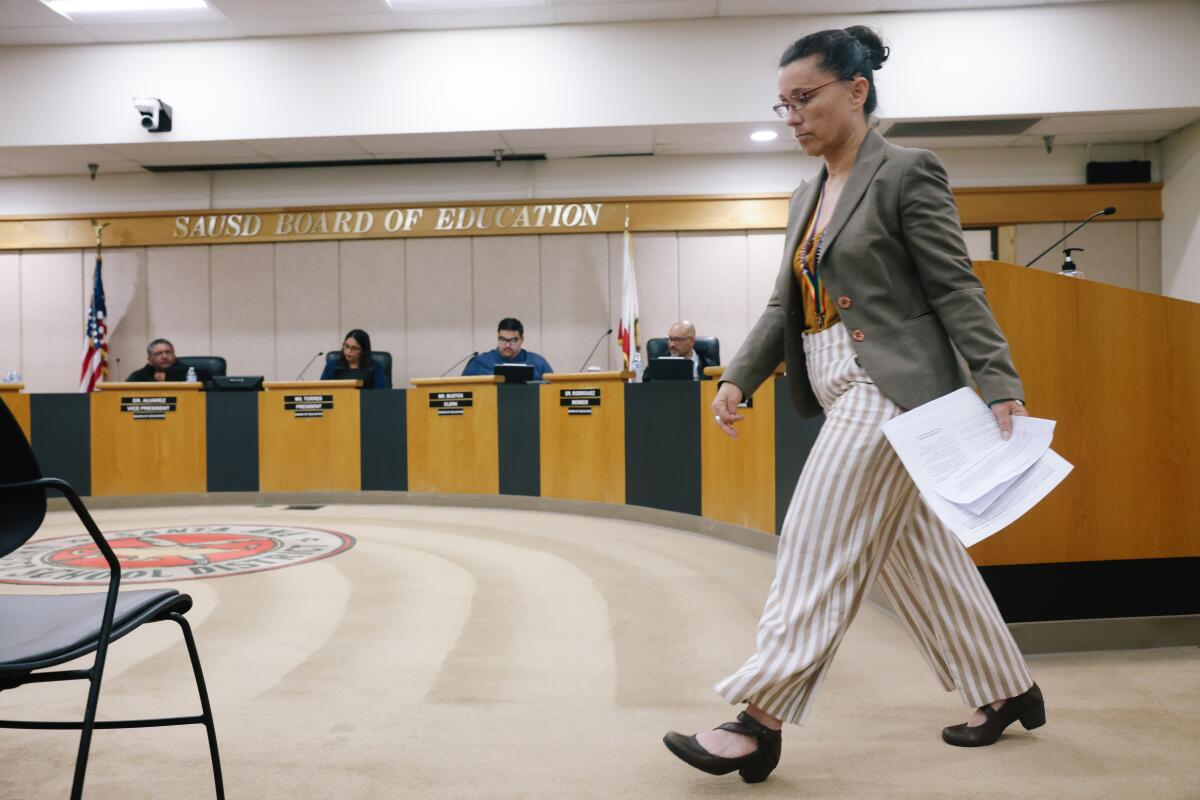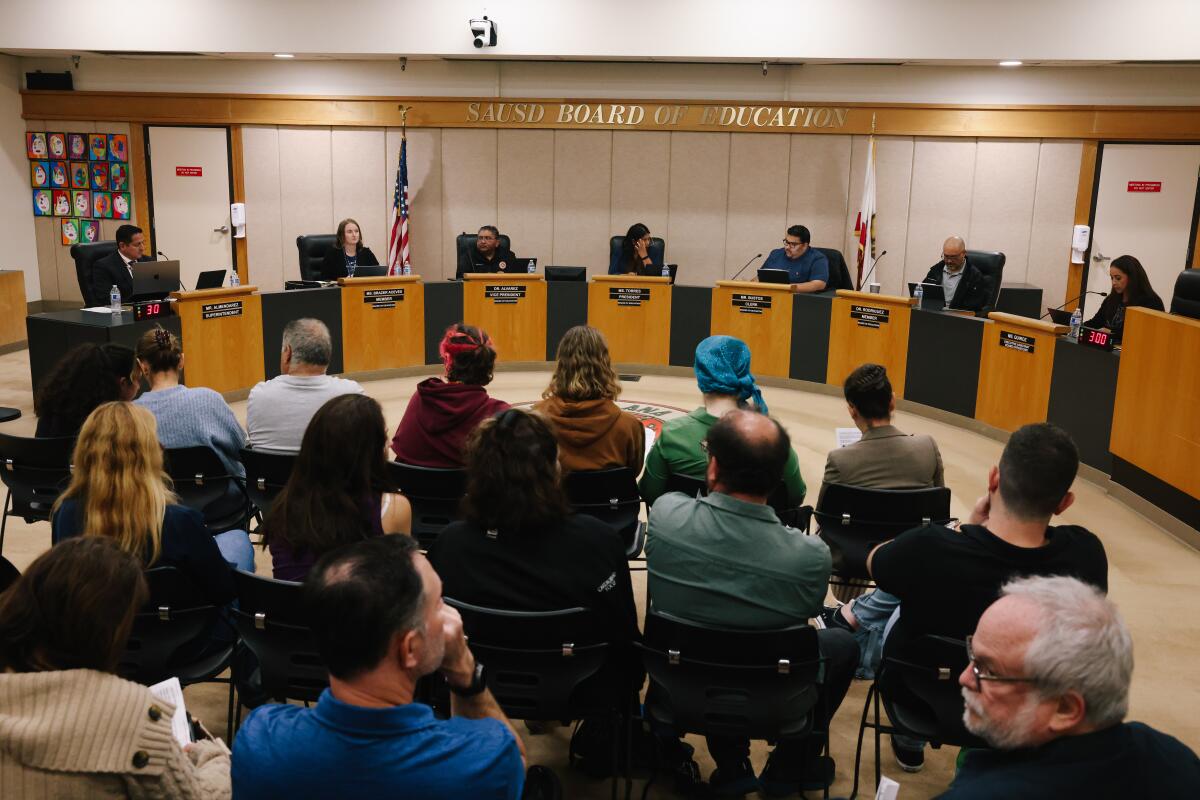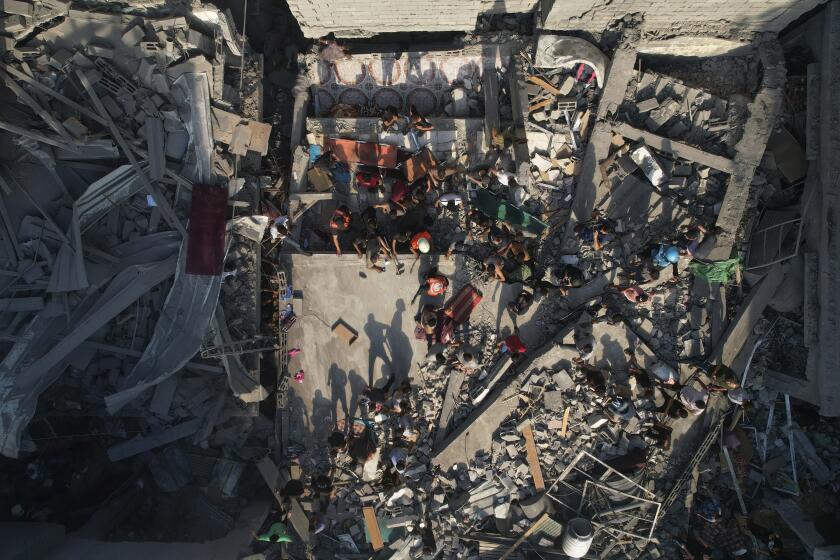Whose stories do we tell? Israeli-Palestinian tensions polarize an Orange County school district

- Share via
Robin Gurien was a lone voice at the start of the discord.
Gurien, a communications professor at Cal State Fullerton, stood before Santa Ana Unified school board members last April to share concerns about the district’s plans to adopt two new ethnic study courses for high school students. One, under the rubric of world geography, featured lessons on the decades-long struggle between Israelis and Palestinians over land and autonomy.
A proposed outline for the course encouraged students to critically assess the United Nations’ 1947 resolution to create a Jewish state in Arab territories then under British control. The board had already approved another ethnic studies class, this one part of the English literature curriculum, that includes lessons on the 1985 assassination of Alex Odeh, a Palestinian American activist killed when a bomb exploded in the Santa Ana office of the American-Arab Anti-Discrimination Committee, where Odeh worked as regional director. The FBI labeled the bombing a terrorist attack carried out by “Jewish extremist elements,” though no suspects were ever charged.
Gurien worried that students exposed to the lessons would come away with a warped impression of Jews. “The Jewish experience,” Gurien said, “is being characterized as violent and extreme.”
Santa Ana trustees nonetheless gave the go-ahead for the courses, clearing the way for students to enroll next fall.

In the months since, Gurien’s lone voice of concern has been joined by a chorus of condemnation from leading Jewish groups over how — and why — Orange County’s third-largest school district is wading into lessons about a fervent conflict more than 7,500 miles away. In September, a coalition of Jewish advocacy groups filed a lawsuit to stop the classes from being taught, alleging that Santa Ana Unified developed the ethnic studies curriculum in “secrecy” and failed to protect Jewish Americans who were “harassed” when speaking out during a board meeting.
As opposition mounted, residents of Arab descent — some donning keffiyeh scarves as a symbol of Palestinian resistance — packed a May school board meeting to rally in support of new lessons they said at last offered a “factual” portrayal of the plight of Palestinians living under Israeli occupation. The proposed lessons feature units on Israel’s Gaza blockade and the controversial West Bank “firing zones” that Israel maintains are needed for military training and Palestinian activists contend are being used to co-opt land for Israeli settlers.
The dissension over Santa Ana’s lesson plans was building well before the Israeli-Palestinian conflict exploded onto the forefront this month, after Hamas militants broke out of the blockaded Gaza Strip and launched a stunning assault, killing more than 1,400 Israeli civilians and soldiers. The massacre was both brutal and unsparing: Unarmed civilians — men, women and children — were gunned down in their homes and yards; the dead included people waiting at bus stops and engaged in routine chores, people dancing at a music festival and cowering in bushes.
Israel’s retaliatory airstrikes have leveled whole neighborhoods in Gaza, killing more than 2,800 Palestinians. Israel has cut off entry of food, water, fuel and medicine into the heavily populated territory, setting off a deepening humanitarian crisis and forcing more than 1 million Palestinians from their homes.
As death tolls climb — and prolonged war seems likely — Santa Ana Unified’s efforts to educate students on the long-standing tensions appear prescient. But the unfolding events, and untold suffering on both sides, risk hardening divisions over how such lessons should be framed.
Arab American community leaders say they are grateful Santa Ana is embracing coursework that sheds light on their immigrant stories. While Santa Ana Unified is 96% Latino, neighboring Anaheim is home to Little Arabia, an ethnic enclave that has become a cultural hub for Arab Americans across Southern California.
“Many of us are here because Israel occupied Palestinian land,” said Rashad Al-Dabbagh, executive director of the Anaheim-based Arab American Civic Council. “Palestinian families were forced out of their homes and became refugees in exile.”
This month’s developments, Al-Dabbagh said, make it all the more crucial that students have a full grasp of cause and effect.
“What we’re hearing from the news and politicians parrots Israel’s narrative, as if what happened [Oct. 7] took place in a vacuum,” he said. “It’s important to teach the root causes and the history so that the next generation can learn what really happened.”
On the other side, James Pasch, senior director for national litigation at the Anti-Defamation League, one of the groups suing Santa Ana Unified, drew parallels between what he sees as the “anti-Israeli” ideology imbued in the district’s proposed lesson plans and the groups now looking to explain and justify Hamas’ deadly rampage.
“It shines a light on why it matters that there never be course material which includes dangerously antisemitic teachings,” Pasch said. “It’s more important than ever that such material not enter our classrooms.”
The fractious discourse offers a disconcerting glimpse of what’s ahead for a variety of cultural groups as school districts across California move to develop ethnic studies courses in response to new state requirements. In 2021, California became the first state to make ethnic studies a required class for high school graduation, a regulation that takes effect statewide for the class of 2030. Supporters say the requirement will help students understand past and present struggles and contributions of groups that have experienced protracted racism and marginalization.
Palestinians in the Gaza Strip stocking up at bakeries and grocery stores, fearing an Israeli ground incursion on top of the air campaign against Hamas.
Preliminary efforts to develop state guidelines for the ethnic studies curriculum focused largely on the experiences of four U.S. racial and ethnic groups — Black Americans, Latinos, Asian Americans and Native Americans. But an early version of the model curriculum drafted in 2019 drew complaints from Jews, Arabs, Armenians, Sikhs and other communities who said their stories were not being told.
“What we’re seeing play out, both with the state model curriculum debate and now, is that California is a much more diverse state than it was perhaps even 15 years ago,” said Thomas Dee, a Stanford education professor. “Understandably, communities want some voice in that.”
As state leaders worked to expand and revise the guidelines, they wrestled with sharply conflicting approaches to ethnic studies. At the university level, ethnic studies departments evolved with the distinct aim of exploring historical events from the perspectives of groups oppressed or marginalized by established economic and political power structures. The original draft of the state teaching guide adopted that anti-imperialist approach, and was rejected as promoting radical ideology and anti-capitalist bias.
In the revised guidelines, state advisors spelled out a key difference in teaching ethnic studies at the K-12 level: “At the college and university level, ethnic studies and related courses are sometimes taught from a specific political point of view,” it reads. “In K-12 education, it’s imperative that students are exposed to multiple perspectives and taught to think critically and form their own opinions.”
Jewish advocacy groups pushed for inclusion in the state’s ethnic studies curriculum, but also criticized as biased proposed coursework involving Israel’s origins and its treatment of Palestinians. The final version included a course in Arab American studies — but exploration of the Israeli-Palestinian conflict did not make the cut.
The state, however, gave school districts flexibility in designing their own classes to meet the ethnic studies requirement, recognizing schools had an interest in tailoring lessons to diverse student bodies. Santa Ana Unified is one of several districts pressing ahead to develop lessons on Israeli-Palestinian tensions.
It’s not clear what prompted Santa Ana Unified — whose families are largely working-class Latino immigrants — to delve into that tortuous history. Supt. Jerry Almendarez declined requests for an interview, as did members of the school board and curriculum advisors with whom the district contracted to help develop the content.
Much of the criticism Jewish groups have levied against Santa Ana’s curriculum echoes concerns expressed on a broader scale during development of the statewide standards: that unfolding history — in this case relations between Israel and Palestinians — through the tight lens of oppressor and oppressed is neither a fair nor full accounting. They say that their opposition is not a wholesale rejection of any lessons on Israel’s role in Mideast turmoil, but that the material must put events in the context of the broader Jewish experience of diaspora, discrimination and genocide.
As currently drafted, Santa Ana Unified’s world geography course urges students to critique the principles underlying the U.N. partition plan that created modern Israel and to consider whether state violence against Palestinians is the consequence of “European imperial nation-making.”
Pasch said the framework omits vital context about the Jewish ancestral connection to Israel, while demonizing the modern state as a “uniquely evil” settler colonial enterprise.
“If the law had been followed appropriately, had there been much more discussion with the Jewish community, some of the issues with the curriculum could have been fleshed out and changed prior to the point we’re at now,” Pasch said.
The Brandeis Center and StandWithUs, leading Jewish advocacy groups, sent Santa Ana Unified a letter in July denouncing the course materials as antisemitic and noting the failure to mention the Jews expelled from Arab and Muslim states and the persistent terrorism Israelis face.
Some Jewish leaders worry that a negative portrayal of Israel will bleed over into discrimination against American Jews, feeding the antisemitism that still pervades some parts of the U.S.
“When there’s a caricature of Jews as oppressors, it commonly reinforces antisemitic tropes,” said Erik Ludwig, president and chief executive of the Jewish Federation of Orange County. “If we’re looking at it from that perspective, then what we want to do is ensure that the curriculum is not promoting a singular narrative of Israel or of Jews.”
After Saturday’s attack by Hamas militants in southern Israel, unofficial security forces are on high alert protecting synagogues, schools and Jewish communities in L.A.
In contrast, the groups supporting Santa Ana’s efforts say opposition to the lesson plans is, at its core, an effort to silence Israel’s critics and part of a wider failure to hold modern Israel accountable for its treatment of Palestinians. They note that other school districts working to devise units on the conflict have also run into controversy.
The Deborah Project, a pro-Israel nonprofit law firm, filed a lawsuit in May against Hayward Unified and demanded it turn over documents related to any curriculum development on the Israeli-Palestinian conflict. In Mountain View-Los Altos Union High School District, pro-Israel groups blasted officials for working with a consultant they accused of antisemitism.
“You can be critical of the Israeli government without being antisemitic,” said Masih Fouladi, deputy executive director of the Council on American-Islamic Relations in Los Angeles.
Shira Klein, a professor who chairs the history department at Chapman University, said she became aware of concerns over the proposed courses in Santa Ana Unified through Jewish social media groups. Soon after, a friend from Klein’s synagogue asked her to review the course outlines. Klein, who specializes in Jewish migration and the Holocaust, said she didn’t find the suggested teaching materials to be antisemitic.
“None of the sources reflected or promoted bias or bigotry,” she added.
Klein shared her conclusions with Jewish activists, who disagreed with her assessment. Klein then helped draft an open letter, which has garnered thousands of signatures, calling on Jewish Americans to support Palestinians living under Israeli occupation.
“I don’t think the solution is to change the curriculum,” she said in September. “The solution is to change what is happening in Israel so that we don’t have to teach that kind of curriculum.”
Reached again last week, Klein said she is still processing the latest cycle of violence and how it relates to the Santa Ana curriculum discussion.
Amid the push and pull, Santa Ana officials have continued to meet with community members and are still refining the curriculum. Supt. Almendarez’s sole public statement on the controversy came during a May 23 school board meeting.
“The district has no intentions of removing any narrative from the curriculum that will be developed in the future,” Almendarez said at the meeting. “Our intent is to listen to all sides, to learn from all sides and to approach this in a balanced manner.”
Arab American groups regard his pledge as a small-scale victory denied them during the statewide curriculum battle. They are planning to mobilize another show of support for the classes at a board meeting later this month.
More to Read
Sign up for Essential California
The most important California stories and recommendations in your inbox every morning.
You may occasionally receive promotional content from the Los Angeles Times.
















